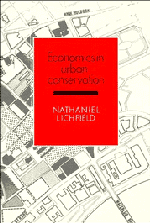Book contents
- Frontmatter
- Contents
- List of diagrams, tables and plans
- Preface
- Acknowledgements
- Introduction
- Part I Planning and management in the conservation of the urban system
- Part II Conservation of the cultural built heritage
- Part III Economics in urban conservation
- 7 Economics in the management of the built environment
- 8 Economics in the conservation of the CBH
- 9 Economics in planning for conservation of the CBH
- 10 Valuation of the cultural built heritage
- 11 Screening of the inventory or list
- 12 Who benefits and who loses from conservation of the CBH?
- Part IV Selected tools of economic analysis for project evaluation
- Part V Case studies in the economics of conservation of the CBH
- Notes
- Bibliography
- Index
11 - Screening of the inventory or list
Published online by Cambridge University Press: 10 November 2010
- Frontmatter
- Contents
- List of diagrams, tables and plans
- Preface
- Acknowledgements
- Introduction
- Part I Planning and management in the conservation of the urban system
- Part II Conservation of the cultural built heritage
- Part III Economics in urban conservation
- 7 Economics in the management of the built environment
- 8 Economics in the conservation of the CBH
- 9 Economics in planning for conservation of the CBH
- 10 Valuation of the cultural built heritage
- 11 Screening of the inventory or list
- 12 Who benefits and who loses from conservation of the CBH?
- Part IV Selected tools of economic analysis for project evaluation
- Part V Case studies in the economics of conservation of the CBH
- Notes
- Bibliography
- Index
Summary
The issue
From the preceding (Chapter 10) it is apparent that some identification of comparative heritage value is needed if ‘heritage value for money’ is to be achieved in conservation. Since some such identification already exists in the preparation of inventories (for ancient monuments, archaeological areas, conservation areas and listed buildings) the question arises: does not the inventory already provide the information?
The answer varies for the four items. Monuments are generally well covered because of their relative scarcity and age. There is only a small inventory for archaeological areas for, by definition, they have not all been explored. Conservation areas are intended as broad brush indicators, within which there is flexibility of interpretation. It is in the buildings and other specific objects that the real difficulty arises, for they are so numerous, are very disparate in nature and their inclusion has great significance for owners and developers, since each can be the focus of the development/conservation conflict. We therefore concentrate on them in this chapter, within the framework of British practice. To what extent is the inventory a conclusive statement of comparative heritage tenure?
Nature and purpose of the list
In practice in Britain the inventory of buildings, etc. is the basis for the official list (5.2) whose prime purpose is to convey a warning, backed by legislative teeth, to those concerned that they own/occupy a building, etc. with ‘heritage tenure’ which must be respected.
- Type
- Chapter
- Information
- Economics in Urban Conservation , pp. 192 - 200Publisher: Cambridge University PressPrint publication year: 1989



